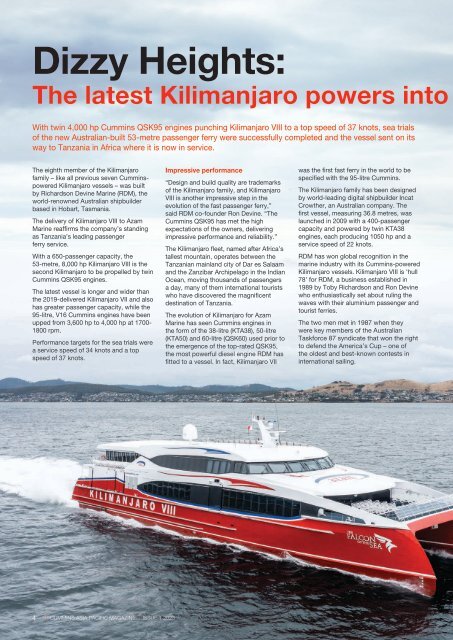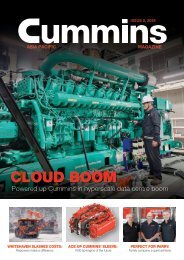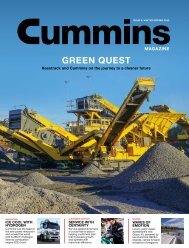Cummins Asia Pacific Magazine - Issue 1 2023
The 2023 edition of the Cummins Magazine for Asia Pacific is now available!
The 2023 edition of the Cummins Magazine for Asia Pacific is now available!
Create successful ePaper yourself
Turn your PDF publications into a flip-book with our unique Google optimized e-Paper software.
Dizzy Heights:<br />
The latest Kilimanjaro powers into<br />
With twin 4,000 hp <strong>Cummins</strong> QSK95 engines punching Kilimanjaro VIII to a top speed of 37 knots, sea trials<br />
of the new Australian-built 53-metre passenger ferry were successfully completed and the vessel sent on its<br />
way to Tanzania in Africa where it is now in service.<br />
The eighth member of the Kilimanjaro<br />
family – like all previous seven <strong>Cummins</strong>powered<br />
Kilimanjaro vessels – was built<br />
by Richardson Devine Marine (RDM), the<br />
world-renowned Australian shipbuilder<br />
based in Hobart, Tasmania.<br />
The delivery of Kilimanjaro VIII to Azam<br />
Marine reaffirms the company’s standing<br />
as Tanzania’s leading passenger<br />
ferry service.<br />
With a 650-passenger capacity, the<br />
53-metre, 8,000 hp Kilimanjaro VIII is the<br />
second Kilimanjaro to be propelled by twin<br />
<strong>Cummins</strong> QSK95 engines.<br />
The latest vessel is longer and wider than<br />
the 2019-delivered Kilimanjaro VII and also<br />
has greater passenger capacity, while the<br />
95-litre, V16 <strong>Cummins</strong> engines have been<br />
upped from 3,600 hp to 4,000 hp at 1700-<br />
1800 rpm.<br />
Performance targets for the sea trials were<br />
a service speed of 34 knots and a top<br />
speed of 37 knots.<br />
Impressive performance<br />
“Design and build quality are trademarks<br />
of the Kilimanjaro family, and Kilimanjaro<br />
VIII is another impressive step in the<br />
evolution of the fast passenger ferry,”<br />
said RDM co-founder Ron Devine. “The<br />
<strong>Cummins</strong> QSK95 has met the high<br />
expectations of the owners, delivering<br />
impressive performance and reliability.”<br />
The Kilimanjaro fleet, named after Africa’s<br />
tallest mountain, operates between the<br />
Tanzanian mainland city of Dar es Salaam<br />
and the Zanzibar Archipelago in the Indian<br />
Ocean, moving thousands of passengers<br />
a day, many of them international tourists<br />
who have discovered the magnificent<br />
destination of Tanzania.<br />
The evolution of Kilimanjaro for Azam<br />
Marine has seen <strong>Cummins</strong> engines in<br />
the form of the 38-litre (KTA38), 50-litre<br />
(KTA50) and 60-litre (QSK60) used prior to<br />
the emergence of the top-rated QSK95,<br />
the most powerful diesel engine RDM has<br />
fitted to a vessel. In fact, Kilimanjaro VII<br />
was the first fast ferry in the world to be<br />
specified with the 95-litre <strong>Cummins</strong>.<br />
The Kilimanjaro family has been designed<br />
by world-leading digital shipbuilder Incat<br />
Crowther, an Australian company. The<br />
first vessel, measuring 36.8 metres, was<br />
launched in 2009 with a 400-passenger<br />
capacity and powered by twin KTA38<br />
engines, each producing 1050 hp and a<br />
service speed of 22 knots.<br />
RDM has won global recognition in the<br />
marine industry with its <strong>Cummins</strong>-powered<br />
Kilimanjaro vessels. Kilimanjaro VIII is ‘hull<br />
78’ for RDM, a business established in<br />
1989 by Toby Richardson and Ron Devine<br />
who enthusiastically set about ruling the<br />
waves with their aluminium passenger and<br />
tourist ferries.<br />
The two men met in 1987 when they<br />
were key members of the Australian<br />
Taskforce 87 syndicate that won the right<br />
to defend the America’s Cup – one of<br />
the oldest and best-known contests in<br />
international sailing.<br />
4 | CUMMINS ASIA PACIFIC MAGAZINE | ISSUE 1 <strong>2023</strong>





